Related Research Articles

USS Galena was a wooden-hulled broadside ironclad built for the United States Navy during the American Civil War. The ship was initially assigned to the North Atlantic Blockading Squadron and supported Union forces during the Peninsula Campaign in 1862. She was damaged during the Battle of Drewry's Bluff because her armor was too thin to prevent Confederate shots from the guns of Fort Darling from penetrating her hull. Widely regarded as a failure, Galena was reconstructed without most of her armor in 1863 and transferred to the West Gulf Blockading Squadron in 1864. The ship participated in the Battle of Mobile Bay and the subsequent Siege of Fort Morgan in August. She was briefly transferred to the East Gulf Blockading Squadron in September before she was sent to Philadelphia, Pennsylvania for repairs in November.
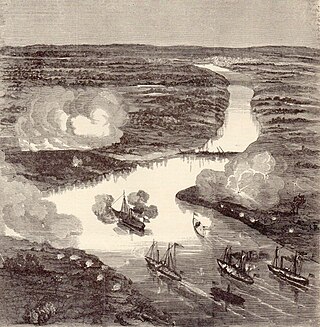
The Battle of Drewry's Bluff, also known as the Battle of Fort Darling, or Fort Drewry, took place on May 15, 1862, in Chesterfield County, Virginia, as part of the Peninsula Campaign of the American Civil War. Four Union Navy warships, including the ironclads USS Monitor and Galena, and the United States Revenue Cutter Service's ironclad USRC Naugatuck steamed up the James River to test the defenses of Richmond, Virginia, the Confederate capital. They encountered submerged obstacles, and the batteries of Fort Darling at Drewry's Bluff inflicted severe damage on Galena, forcing the ships to turn back.
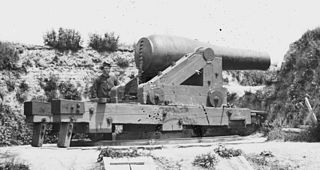
Fort Darling was a Confederate military installation during the American Civil War located at Drewry's Bluff, a high point of 80–100 feet overlooking a bend in the James River south of Richmond in Chesterfield County, Virginia. It protected the Confederate capital of Richmond from Union naval attacks throughout most of the war.

Elmer Charles Bigelow was a United States Navy sailor and a recipient of America's highest military decoration, the Medal of Honor.

John Freeman Mackie was a United States Marine Corps sergeant during the American Civil War. He was awarded the nation's highest military decoration for valor—the Medal of Honor, for his actions aboard the USS Galena during the battle with Confederate Marines and artillery batteries at Fort Darling near Richmond, Virginia, on May 15, 1862. He is one of the first two Marines to be awarded the Medal of Honor, and is considered to be the first Marine to receive the Medal of Honor in the history of the Marine Corps.

The Joint Expedition Against Franklin was a joint engagement between the United States Army and Navy against the Confederate States Army during the American Civil War. The engagement was intended to move Union forces into an area where Confederate forces were gathering as they prepared to move on Suffolk, Virginia. Originally planned as a coordinated two-pronged attack with a naval flotilla supporting an infantry advance on Franklin, Virginia, communications delays caused the Union Navy to start the mission before the Army was ready to support it. Instead, October 3, 1862 found Union Naval forces on the Blackwater River greatly outnumbered by Confederate infantrymen and ultimately forced to retreat. The naval action alone is also known as the Action at Crumpler's Bluff or the Battle of Crumpler's Bluff.
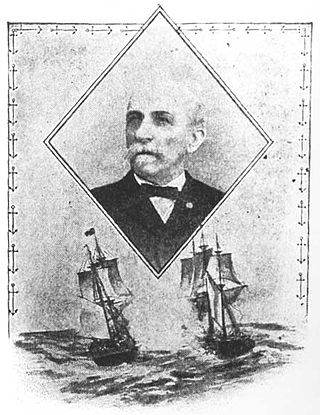
Joseph Ebur Vantine was a United States Navy sailor and a recipient of the United States military's highest decoration—the Medal of Honor—for his actions in the American Civil War.

USRC Naugatuck was a twin-screw ironclad experimental steamer operated by the U.S. Revenue Cutter Service during the American Civil War. She served the U.S. Treasury Department as the USRC E.A. Stevens, a name she retained until sold in 1890. She was loaned to the Navy by the Treasury Department and thus mistakenly referred to in U.S. Navy dispatches during early 1862 as "USS Naugatuck".

George H. Harrison was an American sailor who received the Medal of Honor for valor in action during the American Civil War.

Thomas H. Cripps was a native of Philadelphia, Pennsylvania who was awarded the U.S. Medal of Honor during the American Civil War. While serving in the Union Navy as a quartermaster aboard the USS Richmond, he operated one of that's ship's guns under heavy enemy fire for two hours during the Battle of Mobile Bay, Alabama on August 5, 1864, helping to damage the CSS Tennessee and destroy artillery batteries of the Confederate States Army at Fort Morgan, even as the enemy's shell and shot damaged his ship and killed several of his fellow crewmen. For those actions, he was awarded his nation's highest honor for bravery on December 31, 1864.
Thomas Bourne was a Union Navy sailor in the American Civil War and a recipient of the United States military's highest decoration, the Medal of Honor, for his actions at the Battle of Forts Jackson and St. Philip.

Joseph White was a sailor in the U.S. Navy during the American Civil War. He received the Medal of Honor for his actions during the Second Battle of Fort Fisher on January 15, 1865.

Charles Robinson was a Union Navy sailor in the American Civil War and a recipient of the U.S. military's highest decoration, the Medal of Honor, for his actions during an expedition on the Yazoo River.
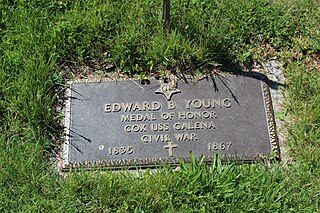
Edward B. Young was a Union Navy sailor in the American Civil War and a recipient of the U.S. military's highest decoration, the Medal of Honor, for his actions at the Battle of Mobile Bay.
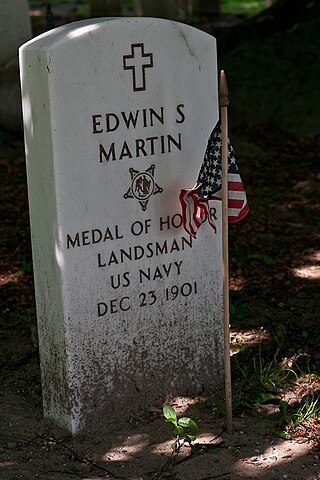
Edward or Edwin S. Martin was a Union Navy sailor in the American Civil War and a recipient of the U.S. military's highest decoration, the Medal of Honor, for his actions at the Battle of Mobile Bay.
Thomas H. Jordan was a Union Navy sailor in the American Civil War and a recipient of the U.S. military's highest decoration, the Medal of Honor, for his actions at the Battle of Mobile Bay.
John Greene was a Union Navy sailor in the American Civil War and a recipient of the U.S. military's highest decoration, the Medal of Honor, for his actions at the Battle of Forts Jackson and St. Philip.
William Martin was a Union Navy sailor in the American Civil War and a recipient of the U.S. military's highest decoration, the Medal of Honor, for his actions at the Battle of Forts Jackson and St. Philip.
Jeremiah Regan was a Quartermaster of the United States Navy who was awarded the Medal of Honor for gallantry during the American Civil War. When his ship, the USS Galena, attacked Drewry's Bluff, Virginia in the Battle of Drewry's Bluff, it was heavily damaged by shellfire with several crewmembers wounded or killed. Despite the danger of the situation, Regan continued to man his gun throughout the engagement. For these actions, he was awarded the Medal of Honor on 3 April 1863 by President Lincoln.
John Kelley was an Irish born recipient of the Medal of Honor and sailor in the Union Navy during the American Civil War.
References
- 1 2 "Charles W Kenyon | U.S. Civil War | U.S. Navy | Medal of Honor Recipient". Congressional Medal of Honor Society. Retrieved 2022-02-07.
- 1 2 3 "Charles Kenyon - Recipient -". valor.militarytimes.com. Retrieved 2022-02-07.
- ↑ "The Navy Medal of Honor". NHHC. Retrieved 2022-02-07.
- ↑ Groom, Debra J. (2011-05-29). "On the 150th anniversary of the Medal of Honor, more about some Central New Yorkers who earned their country's highest tribute". The Post-Standard . Retrieved 2022-02-07.